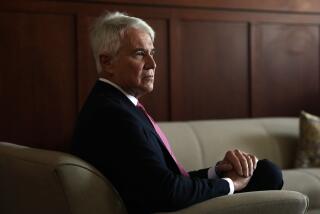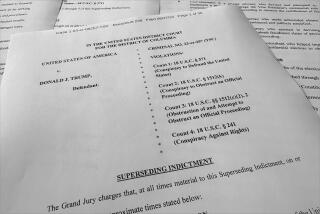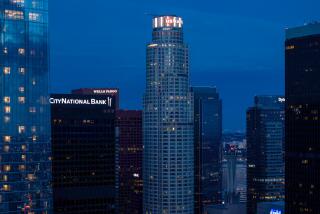U.S. Grand Juries Placed on Trial as Useless Artifacts
The federal prosecutor’s opening statement to the trial jury did not bode well for U.S. Customs Inspector Robert Ramos. Ramos, a five-year Customs employee, had been charged with pocketing a $125,000 bribe for allowing a truck loaded with marijuana through the port of entry at Calexico.
Methodically, the prosecutor laid out the damaging accusations made against Ramos by convicted marijuana smugglers Alberto Scolari and his son, Miguel. The Scolaris, who admitted earning $24 million in illicit drug profits over the past 10 years, reached a deal with the U.S. attorney’s office and volunteered to incriminate Ramos in exchange for leniency.
Most of the charges against Ramos in a federal grand jury indictment stemmed from allegations by the Scolaris. But what was more interesting was what information the prosecutors declined to tell the jury that brought the indictment.
If federal grand juries operated by the same rules as California grand juries, federal prosecutors would have been forced to make favorable evidence available to the grand jurors. And if that evidence had been shared with the grand jury, defense attorney Eugene G. Iredale believes Ramos would never have been indicted.
Among the crucial bits of evidence that pointed toward Ramos’ innocence but were not included in grand jury transcripts were:
- Alberto Scolari failed to pick Ramos out of a photo lineup.
- Alberto Scolari identified Ramos only after taking three trips to the border with investigators, and picked him out on the third trip after U.S. agents pointed to Ramos.
- The Scolaris had initially told prosecutors that the man they bribed was an immigration official, not a Customs inspector. They described the official’s nameplate to investigators, but Customs inspectors do not wear nameplates.
- Ramos was accused of taking a $125,000 bribe. But a thorough check of his credit and bank records by the Internal Revenue Service turned up no evidence of sudden and unexplained wealth. In fact, Ramos was behind on his bills.
- Customs’ own records showed that Ramos was not inspecting the lane the Scolaris said they used when they drove the tanker truck filled with marijuana across the border.
Federal prosecutors did not even ask Ramos to testify before the jurors who indicted him. Iredale had to wait until trial to present the favorable evidence for his client. After a two-week trial, the jury took less than two hours to clear Ramos of 19 counts involving drug charges, bribery and tax evasion.
While not commenting specifically on the Ramos case, U.S. Atty. Peter K. Nunez said in an interview recently that “exculpatory evidence is for the defendant to introduce at the time of his trial.” (Exculpatory evidence is the evidence favorable to the accused.)
Nunez, whose office has jurisdiction in San Diego and Imperial counties, said that deciding what is exculpatory evidence is often a gray area and not always defined in black and white.
“What you and I think is exculpatory today . . . three months from now after everybody has interviewed all the witnesses . . . we may come to a different legal conclusion as to what’s exculpatory and what’s not,” said Nunez.
In fact, there is no law that requires a federal prosecutor to present exculpatory evidence to a grand jury. But as a matter of policy, Nunez said that the Department of Justice “encourages” federal prosecutors to present exculpatory evidence.
Defense attorneys and critics of the grand jury cite the Ramos case as one of several examples in arguing for grand jury reform because of what they say is prosecutorial abuse.
The federal grand jury, which is mandated by the Fifth Amendment, has remained virtually unchanged since the adoption of the Constitution. All federal criminal cases begin with a grand jury indictment.
Calls for reform of the federal grand jury system have come not only from individual lawyers but from the American Bar Assn. as well. Some of the reforms suggested by the ABA include the hotly contested issue of allowing defense lawyers in the grand jury room; informing every witness about his right against self-incrimination and right to counsel; telling target witnesses they are possible indictees; presenting exculpatory evidence to the grand jury; allowing grand jury targets the right to testify, providing they sign waivers of immunity, and ending the practice of presenting evidence to the grand jury that is constitutionally inadmissible at trial.
The grand jury as an institution goes back to the 12th Century and is rooted in English common law. By bringing together a group of citizens to hear evidence from prosecutors, the grand jury was founded with the idea that it would shield the innocent from unwarranted prosecution. But grand jury critics like Richard E. Gerstein, a Florida prosecutor for 26 years and now a defense attorney, say that what started out as a good idea--shielding citizens from unwarranted prosecution--is now used as a powerful and arbitrary tool by some prosecutors.
“I can’t remember when I last saw the shield,” Gerstein said. “Today, the potential for abuse is certainly there. The grand jury is supposed to be impartial, but the fact is that most grand juries hear only the prosecution’s side. The prosecutor decides what evidence to present and advises the jurors on the law. If the prosecutor chooses not to introduce evidence that negates guilt, how are the jurors supposed to act in an impartial manner when deciding whether or not to indict?”
These criticisms are not new or unique to the United States. English lawmakers, citing charges of prosecutorial abuse, abolished the grand jury in 1933.
A 1982 study by the American Bar Assn. noted the increasing cries by grand jury critics for reform of the system. In California, legislation and state Supreme Court rulings have greatly curtailed the powers of the county grand juries.
A 1978 state Supreme Court ruling allows every defendant charged with a felony the right to a preliminary hearing, at which a judge decides if there is enough evidence against the accused to warrant a trial. Preliminary hearings are rare in the federal courts. Cases usually go to trial within weeks of a federal indictment unless the accused pleads guilty.
The court ruling has drastically reduced the role of the state grand jury in criminal indictments.
“Prosecutors in this state have chosen to abandon the grand jury except in rare instances because it’s just not a very practical institution anymore,” said San Diego County Dist. Atty. Edwin Miller, a member of the President’s Commission on Organized Crime.
Although Miller does not believe that the grand jury in California has outlived its usefulness, he said it has been “diluted.”
“It’s totally impractical to present a major complex case--which may take in some instances several weeks--to the county grand jury and then in essence do it all over again before you have a trial (at a preliminary hearing),” Miller said.
He also noted that, in contrast to a federal grand jury investigation, state prosecutors are required to invite the target of the investigation to testify at the grand jury and to present exculpatory evidence in their possession. Federal prosecutors literally have free reign while leading a grand jury investigation. There are no official guidelines that govern a prosecutor’s conduct in the grand jury room except the integrity of the prosecutor.
The awesome power and influence that federal prosecutors have over a grand jury tends to make the body a tool of the prosecution, said Gerstein.
Although he denies that the grand jury is merely a prosecutorial tool, Nunez acknowledged that “basically, it is one sided.” And it is not uncommon for the grand jury to hear only the prosecution’s side before issuing a federal indictment, said Nunez.
In pursuing an indictment, the Constitution allows a federal prosecutor several advantages, including:
- The right to present evidence to the grand jury that is constitutionally inadmissible at trial. Hearsay evidence--evidence obtained second or third hand--is also permissible.
- In addition to being allowed to keep exculpatory evidence from the grand jury, a prosecutor is under no obligation to inform a person that he is the target of an investigation.
- Even if the person learns he is being investigated, he has no legal right to testify or present his side of the case to the grand jury.
Federal law also allows the use of evidence obtained through wiretaps and electronic surveillance during a grand jury investigation and at trial. California law prohibits the use of any type of electronic surveillance, and evidence obtained through a federal wiretap is inadmissible in state court.
Nunez has heard the complaints about the federal grand jury system and brushes them aside as “a lot of nonsense.” He says that defense lawyers do not like the grand jury “because they know it works and they know it’s effective.”
“My reaction is, ‘What’s the problem?’ ” Nunez said matter of factly. “So what if we use evidence that’s hearsay or evidence that may subsequently be found to be inadmissible? The point is that it still does us no good to get an indictment if we can’t win the case at trial.”
But defense attorneys point out that the indictment alone can be a severe punishment. Although Ramos was acquitted in November, Customs officials have not allowed him to return to work. The loss of Ramos’ job made it impossible for him to make mortgage payments, and his family’s home went into foreclosure.
John Cleary, a top criminal attorney in San Diego, says that the large number of indictments returned by the federal grand jury proves that it is nothing more than a “rubber stamp” of the U.S. attorney’s office.
“They (grand jurors) don’t look for proof of the facts. They look for proof of guilt,” said Cleary. “For the grand jury to even be called a juridical impartiality, it’s a sad, sad joke.”
Grand juries under the direction of Nunez’s office returned 875 indictments in 1983, and Nunez estimated that 1,000 were returned in 1984. Since grand jury proceedings are secret, Nunez said he does not know how many no bills, or no indictments, were returned in both years. But he says that it was “probably not more than a couple.”
Despite the fact that federal grand jury investigations are one sided, they are not unfair, said Nunez.
“In the grand jury there really are no limits on the kind of evidence that it can hear. At trial there are lots of limits. The fact that hearsay is allowed in the grand jury, that’s not a decision that some prosecutor made. That’s a decision made by the people who wrote the Constitution. And I think that’s fair,” said Nunez.
Federal grand juries can be empaneled for up to 18 months, and can be extended for an additional six months. In San Diego, eight grand juries, each consisting of 23 people, are currently empaneled. One panel meets on Wednesday and the other on Friday. The remaining six are convened as necessary.
The law requires a quorum of 16 grand jurors to convene and 12 to return an indictment.
Mario Conti, chief trial attorney for Federal Defenders of San Diego, said it is further proof that the grand jury system is unfair that indictments are often returned when not all of the jurors have heard all of the evidence in the case.
“You’ve got a group of people voting on an indictment, some of whom have not heard everything. Even though what they hear is pretty much prosecutorily oriented, they still haven’t heard everything,” said Conti.
In October, 1979, U.S. District Judge Harry Pregerson in Los Angeles dismissed a federal indictment against a corporation because, of the 19 jurors who voted to return the indictment, only nine attended all of the sessions where evidence was presented. Pregerson ruled that the indictment was returned by less than 12 “informed grand jurors.”
“Of necessity, the grand jury must rely on the evidence presented to it by the prosecutor,” wrote Pregerson. “. . . jurors who are ignorant of some of the evidence presented to the grand jury cannot effectively question the validity of the prosecution’s case.”
Pregerson also noted the crucial role played by the grand jury, particularly at the federal level “where the grand jury is the only potentially neutral body that can protect the individual against the initiation of arbitrary or malevolent prosecutions.”
However, Pregerson was overturned by the U.S. 9th Circuit Court. The court ruled that the Constitution literally requires only that an indictment be returned by 12 grand jurors and does not require them to hear all of the evidence.
“If what the absentees actually hear is enough to satisfy them, there would seem to be no reason why they should not vote,” said the court.
Nunez defended the circuit court’s reversal with the explanation that a grand jury is merely a “charging mechanism” and said that guilt or innocence can only be resolved by a trial jury.
“It (the grand jury) is a body that considers very simply, ‘Is there probable cause?’ It’s not supposed to resolve the ultimate issue of guilt or innocence. It’s a charging mechanism,” Nunez said.
Perhaps the sharpest debate between prosecutors and defense attorneys is the issue of whether lawyers should be allowed inside the grand jury room. Currently, 16 states, but not the federal government and California, allow defense attorneys to accompany their clients when they appear before the grand jury.
In the states where counsel is not allowed in the grand jury room, a witness can step outside and confer with his attorney before answering a question. Gerstein said that this practice prejudices the witness in the eyes of the grand jurors.
“I saw it too often when I was a prosecutor,” he said. “The jurors think that a witness has something to hide if he has to constantly step outside and talk to his attorney before answering a question. Nothing prejudices a grand jury more against a witness--except, perhaps, when he uses the Fifth Amendment to protect himself against self incrimination. Taking the Fifth is too often seen as proof of guilt by the jurors.”
In states where attorneys are allowed in the grand jury, they are only allowed to advise their clients and cannot cross examine witnesses or raise objections. Despite these limitations on attorneys, prosecutors say that their presence still presents problems.
“What kind of obligation to secrecy can you impose on that lawyer who has now been in the grand jury room and has heard all the testimony?” Nunez said.
Miller said that allowing lawyers in the grand jury room “can lead to more mischief.”
Nunez and Miller say there are no restrictions on how many clients a lawyer can represent before a grand jury. They argue that the real reason why lawyers want to be in the grand jury room is to make sure that witnesses do not incriminate their principal client, should he be the target of the investigation.
“Their role is to make sure this witness doesn’t tell you what the true client did . . . and in representing witnesses he’s supposed to keep them quiet if he can,” Nunez said. “Well, even if he can’t keep them quiet he’s in a position now to go back to his true client and tell him what’s going on. This is an inherent difficulty for which no one has figured out an answer.”
But while Nunez and Miller worry that allowing lawyers in the grand jury room will compromise the secrecy of the proceedings, there is nothing in the law that prohibits a witness from publicly discussing his grand jury testimony.
“There’s nothing to stop a witness from holding a press conference after appearing before the grand jury to discuss his testimony,” Iredale said. “How often is a grand jury proceeding compromised anyway? If anything, the hearing is compromised in the government’s favor from the beginning. The government can indict anybody, at any time, for any reason.”
More to Read
Sign up for Essential California
The most important California stories and recommendations in your inbox every morning.
You may occasionally receive promotional content from the Los Angeles Times.










